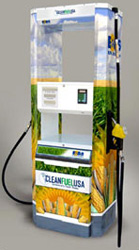 A project north of the border could turn waste plastic into biodiesel.
A project north of the border could turn waste plastic into biodiesel.
This story from CanPlastics.com says Nova Scotia is investing $20 million in government money in the Minas Basin Pulp and Power Company’s expansion project for a biodiesel plastics processing plant for plastic waste.
“We are committed to investing in innovative and resourceful companies that contribute to job growth, a green environment, and a strong economy for Nova Scotia,” said [Nova Scotia Premier Rodney MacDonald] in a statement. “Minas Basin is taking a leadership role by helping to ensure environmental sustainability for this province.”
According to Minas Basin, the new plant will divert 4,000 tons of plastic waste. The governmental investment will allow the company to commit to more than $27 million in capital expenditures.
Company officials say the money will help them move into “the next phase of sustainable restructuring for Minas Basin,” as well as creating a renewable energy supply for the province.


 “I would say our biggest hurdle is the potential cost to the retailer of putting infrastructure in and the education needed to get customers to support that,” said Robert White, of the Ethanol Promotion and Information Council, a trade group.
“I would say our biggest hurdle is the potential cost to the retailer of putting infrastructure in and the education needed to get customers to support that,” said Robert White, of the Ethanol Promotion and Information Council, a trade group. According to a
According to a  Wisconsin’s first soybean crushing facility is being built… thanks to a $4 million grant from the state.
Wisconsin’s first soybean crushing facility is being built… thanks to a $4 million grant from the state. A ferry carrying 124 cars in Washington State’s Puget Sound has been running on biodiesel since last month, and officials are hoping to expand the green fuel into another transport.
A ferry carrying 124 cars in Washington State’s Puget Sound has been running on biodiesel since last month, and officials are hoping to expand the green fuel into another transport. Fifty years ago, you could see acres and acres of flax growing in the southern part of Texas. Today, the crop once grown for vegetable oil, is finding new life as a feedstock for biodiesel.
Fifty years ago, you could see acres and acres of flax growing in the southern part of Texas. Today, the crop once grown for vegetable oil, is finding new life as a feedstock for biodiesel. “It’s kind of like we’re coming full circle,” said Dr. Gaylon Morgan, small grains researcher and member of the Texas A&M AgriLife project team. “Flax was grown on about 400,000 acres during that time and Texas AgriLife Research had an active flax breeding program.
“It’s kind of like we’re coming full circle,” said Dr. Gaylon Morgan, small grains researcher and member of the Texas A&M AgriLife project team. “Flax was grown on about 400,000 acres during that time and Texas AgriLife Research had an active flax breeding program. “Schools, truck drivers, small businesses and families across the commonwealth are feeling the pressure of higher fuel bills on their budgets and wallets,” said McGinty. “Switching from conventional fuels to homegrown biofuels will help break our addiction to foreign oil, bring down costs, strengthen national security, and grow our economy.
“Schools, truck drivers, small businesses and families across the commonwealth are feeling the pressure of higher fuel bills on their budgets and wallets,” said McGinty. “Switching from conventional fuels to homegrown biofuels will help break our addiction to foreign oil, bring down costs, strengthen national security, and grow our economy. Roe explains that Coskata combines both biological and thermochemical processing and can use a wide variety of feedstocks, from wood chips, weeds and non-food crops like miscanthus, to even human waste and carbon-heavy garbage like tires.
Roe explains that Coskata combines both biological and thermochemical processing and can use a wide variety of feedstocks, from wood chips, weeds and non-food crops like miscanthus, to even human waste and carbon-heavy garbage like tires. Sales of alternative fuel vehicles in the United States, including flex-fuel and hybrid electric, reached 1.8 million last year, about 250,000 more than in 2006.
Sales of alternative fuel vehicles in the United States, including flex-fuel and hybrid electric, reached 1.8 million last year, about 250,000 more than in 2006.